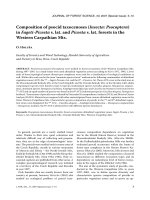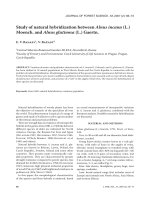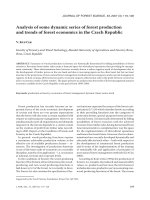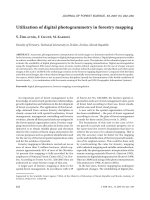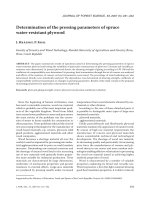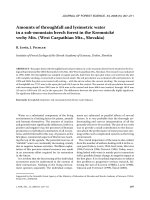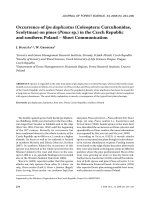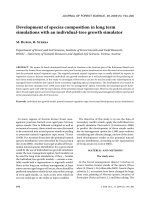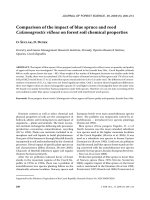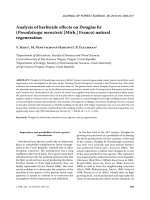Báo cáo lâm nghiệp: "Dynamics of natural regeneration of even-aged beech (Fagus sylvatica L.) stands at different shelterwood densities" pot
Bạn đang xem bản rút gọn của tài liệu. Xem và tải ngay bản đầy đủ của tài liệu tại đây (685.9 KB, 9 trang )
580 J. FOR. SCI., 56, 2010 (12): 580–588
JOURNAL OF FOREST SCIENCE, 56, 2010 (12): 580–588
Dynamics of natural regeneration of even-aged beech
(Fagus sylvatica L.) stands at different shelterwood
densities
J. F. B. P, J. R, L. B
Faculty of Forestry and Wood Sciences, Czech University of Life Sciences Prague, Prague,
Czech Republic
ABSTRACT: The article presents results of research focused on the development of natural regeneration of beech
stands in the National Natural Reserve Voděradské bučiny, based on information acquired in regeneration plots es-
tablished in 2004 and 2009. After five years of the study, 5 different generations of beech, representing 97.4% of the
whole woody regeneration, were registered. In the second year of life, the two oldest generations of seedlings had the
highest mortality registered so far. The last year survival of seedlings was not influenced by increased canopy openings
as a result of harvest or mortality. The data from a new plot with higher stand density confirmed the negative effect of
high parent stand density on the formation of new regeneration. An elevated proportion of litter in the ground cover
was found to be negatively related to the establishment and survival of beech seedlings.
Keywords: European beech; Fagus sylvatica L.; natural regeneration; natural reserve; stand density
Supported by the Ministry of Agriculture of the Czech Republic, Project No. Ql 102A085.
Beech forests of the Czech Republic are mostly lo-
cated in protected areas; beech can be considered
as the most important commercial broadleaved tree
species, playing an important role in the conver-
sion of extensive spruce monocultures (J
2000). e species is traditionally reproduced by
natural regeneration based on the frequency of mast
years, which occur every 4 to 6 years on average,
and such a frequency is said to be encouraged by a
temperature higher than 30 °C from July to Septem-
ber of the prior year, although site index and high
deposition of atmospheric nitrogen can also affect
this frequency positively (Ö et al. 2007).
Flowering and seed production of European beech
begin at about 40–50 years of age (W et al.
2010), and its pollen effectively disperses to less than
250 m within forests (W 2001). Beechnuts com-
monly disperse by barochory usually to around 20 m
(W et al. 2010), but can reach up to 125m by
zoochorous dispersal even introducing beech into
stands of other species (K 2004). Accord-
ing to S and K (2008), the quite
strong growth rate of fine roots in beech seedlings
during the first 4 years makes it appropriate for
plantations. Additionally, for successful develop-
ment, young plants need protection from parent
trees against late frost, drought and high tempera-
tures (H 2004). e local high density of beech
seedlings has a strong negative influence on their
diameter growth and a smaller influence on height
growth (C, C 2006). According to
W and O (1998), beech seedlings
preserve a higher portion of biomass in the shoot
than in the root during the first year of life, which
favours photosynthesis and supports a good adap-
tation to low light conditions, making the species
suitable for regeneration under shelterwood. M-
and L (1997) stated that larger canopy
openings show higher variance in height growth and
higher sapling density of beech seedlings. e same
authors also affirmed that higher soil water content
increases the regeneration growth while an increase
in soil carbon content has the opposite effect, pos-
sibly due to the accumulation of raw humus, which
J. FOR. SCI., 56, 2010 (12): 580–588 581
results in poor nutrient supply. Similarly, under ap-
propriate supply of water in the soil and sufficient
fertilization, a relatively open canopy can generate
convenient conditions for a large increase of beech
seedling growth (M 1995). ere is also a re-
lation between different provenances of beech in Eu-
rope and their response to soil water content, so that
provenances from lower altitudes show higher incre-
ments in growth under conditions of high soil water
content as a sign of adaptation to longer vegetation
period and higher precipitation amount (N,
J 2003). Different studies showed that al-
though beech possesses mechanisms for responding
to water deficits, it is not a drought-tolerant species
(F et al. 2009). When competition is strong,
beech trees show a high sensitivity to water bal-
ance whereas, at a low competition level, trees react
positively to high temperatures (C, P
1998). Seedling growth has also been related to light
availability and root density of old beech (W
1999).
e aim of the study was to investigate the long-
term development of seedling banks under dif-
ferent stand conditions after heavy mast year and
following secondary beech fructifications in the
locality of the Voděradské bučiny National Nature
Reserve (NNR).
MATERIALS AND METHODS
e Voděradské bučiny National Nature Reserve
was established in 1955 within an area of 658 ha.
Most of the forest stands originated in the period
1820–1850 as a result of a very intense three-phase
shelterwood system with the very short regenera-
tion period lasting approximately over 15 years,
which, in consequence, formed even-aged stands
with the relatively simple vertical and horizontal
structure that prevail on the major part of the re-
serve. Only a few patches of several hectares of old-
growth forests were left unmanaged since 1955 on
the area, and they exhibit relatively heterogeneous
stand structures (B et al. 2009).
In 1980, five 1 ha permanent research plots (PRP)
were established in even-aged beech forest stands of
the NNR in order to analyze their stand structure. In
2004, four of these plots (plots 1, 3, 4 and5) were used
again for a broader evaluation of their structure (Ta-
ble 1) involving the measurement of dbh (diameter
at breast height), total height, crown height, species,
social status (dominant, codominant, subdominant
and less than 20 m) and horizontal distribution using
the Fieldmap equipment (IFER Monitoring and Map-
ping Solutions Ltd., Jílové u Prahy, Czech Republic).
e evaluation of horizontal distribution included a
description of the crown projection of each live stem
by measuring a minimum of five cardinal crown radii
per tree. For the study of the natural regeneration, a
regular matrix of 20 × 10 m was set throughout the ex-
tent of each 1 ha PRP. Each intersection of the matrix
(marked with a wooden stake) indicates the corner
of a 1 m
2
square subplot, in which the quantification
of seedlings and survival according to cohorts (gen-
erations) was registered repeatedly at the end of the
vegetation period in 2004, 2005, 2007, 2008 and 2009.
Each cohort found in this study is defined by the year
of the seed production, which is one year before the
germination of seedlings. In the first year of the study
we distinguished only between 1-year-old seedlings
and older ones (originating mostly from the mast year
in 1995). In the same year, we registered the descrip-
tion of the ground cover by determining the percent-
ages of woody regeneration, herb vegetation, dead
wood, stones, mineral soil, soil covered with litter fall,
roots, roads and moss, as well as the total thickness
Table 1. Stand characteristics of permanent research plots included in the study, after evaluation in 2009
PRP
Forest
stand
V G N ρ
D
mean
H
mean
Crown
cover (%)
Forest
type
Age
(years)
Elevation
(m.a.s.l.)
Exposure
slope (%)
1 436C17 477.5 21.6 65 0.47 63.5 40.9 60.6 4B1 180 440 E – 15
2 32D15z 623.0 42.5 304 1.21 40.9 28.3 100.4 4K3 165 490 Plain
3 434B17 800.6 37.7 117 0.82 62.8 40.0 97.6 4S4 190 450 N – 20
4 434E17 606.6 28.3 90 0.62 62.0 40.0 69.3 4S4 185 460 E – 17
5 436D17 576.0 27.8 110 0.63 55.7 39.3 75.1 4K3 170 440 E – 15
PRP – permanent research plot, V – volume (calculated for timber above 7 cm of diameter over bark (m
3
·ha
–1
)), G – basal
area (m
2
·ha
–1
), N – number of trees (individuals·ha
–1
), ρ – stand density, D mean – mean dbh (cm), H mean – mean total
height (m)
582 J. FOR. SCI., 56, 2010 (12): 580–588
of holorganic and Ah horizons (double measurement
in the opposite corners of the plot) and distance to
the nearest tree. In 2009, the fifth of the PRP’s initially
established in 1980 (PRP 2) was also included in our
research for the study of stand structure and natural
regeneration (Table 1), and therefore, for this plot, we
registered two cohorts only (cohort 2008 and older
than 2008). e silvicultural system applied in the
area is shelterwood, although on two PRP (3 and 4),
a combination of shelterwood and border cutting is
carried out. Due to the lack of normality in the data
distribution, it was necessary to include in the calcu-
lations the Kruskal-Wallis non-parametric method to
determine the degree of statistical difference among
samples, and the Spearman correlation coefficient to
verify correlations between variables. e Statgraph-
ics Centurion XV software was employed for the cal-
culations of statistical values.
RESULTS
Considering PRP’s 1, 3, 4, 5, besides beech other
10 species were present in the woody regenera-
tion: Norway spruce (Picea abies [L.] Karst.), syca-
more maple (Acer pseudoplatanus L.), hornbeam
(Carpinus betulus L.), silver birch (Betula pendula
Roth.), larch (Larix decidua Mill.), rowan (Sorbus
aucuparia L.), willow (Salix caprea L.), silver fir
(Abies alba Mill.), Scotch pine (Pinus sylvestris L.),
and poplar (Populus tremula L.), which account for
1.24, 0.56, 0.34, 0.28, 0.28, 0.17, 0.17, 0.17, 0.11 and
0.11 thousand individuals per hectare on average,
respectively. Most of them were registered after
2007 and emerged at the border of the stands. In
2009, these species represented 2.6% of the total
woody regeneration in the four PRP’s. is concurs
with the proportion of species in the canopy, since
beech represents 99.2% of the canopy individuals
in the plots of the study, regardless of the existence
of patches of other species in the surroundings of
the area.
e total number of beech seedlings registered
for plots 1, 3, 4 and 5 till 2009 (Table 2) shows the
highest density of the regeneration of cohort 2003
in plot 1, with almost 300 thousand seedlings per
ha during the first year (Fig. 1). After five years of
study, the number of seedlings remaining from
Table 2. Average density of beech seedlings on four permanent research plots (thousands per hectare) and values for
the Kruskal Wallis test
Year of evaluation Cohort PRP 1 PRP 3 PRP 4 PRP 5 Kruskal-Wallis test H P-value
2004
older than 2003 13.8
a
6.7
b
30.3
abc
5.5
c
23.64 0.000
2003 298.8
a
78.1
ab
197.0 167.9
b
8.84 0.031
2005
olther than 2003 11.8
a
6.3
b
24.2
abc
4.2
c
13.74 0.003
2003 218.2
ab
36.9
ac
68.8
bd
114.3
cd
14.85 0.002
2007
older than 2003 10.9
a
6.1
b
23.7
abc
3.1
c
18.43 0.000
2003 202.6
ab
24.4
ac
50.3
bd
94.9
cd
18.23 0.000
2006 64.8
ab
75.4
cd
9.0
ac
22.7
bd
47.12 0.000
2008
older than 2003 10.0
a
5.8
b
21.8
abc
3.0
c
16.46 0.001
2003 201.4
ab
24.2
ac
42.8
bd
94.3
cd
20.96 0.000
2006 47.7
ab
40.6
c
4.4
acd
18.4
bd
38.37 0.000
2007 5.2
ab
0.6
a
0.0
bc
2.8
c
12.18 0.007
2009
older than 2003 10.0
a
5.8
b
21.5
abc
2.8
c
15.86 0.001
2003 191.4
ab
21.7
ac
39.0
bd
89.4
cd
22.66 0.000
2006 42.8
ab
30.3
cd
2.8
ace
12.6
bde
44.68 0.000
2007 3.7
ab
0.3
a
0.0
bc
1.2
c
9.69 0.021
2008 16.9
abc
3.8
a
6.6
b
4.5
c
15.61 0.001
total (2009) 264.7 61.9 69.9 110.6 – –
P-value – probability for the Kruskal Wallis test; values marked with the same latter (a, b, c, d, e) indicate statistical differ-
ence between plots
J. FOR. SCI., 56, 2010 (12): 580–588 583
those 300 thousand·ha
–1
equals the initial number
of seedlings of the same cohort in plot 4 (almost
200 thousand·ha
–1
), which is the second highest
density among the four plots in 2004. e plots
show a similar tendency of decrease for this cohort
during the years, except for plot 4, which presents
a higher decrease during the second year, placing it
as the third highest density among the plots. ese
results do not concur with the number of seedlings
older than 2003 (Fig. 2), given that in the last case
the highest density is reached by plot 4, and plot
1 takes the second place. As stated by B et al.
(2009), the density of young seedlings is negatively
influenced by the presence of older cohorts.
In 2009, a recount of the stock of research plots
registered a reduction in the number of parent
trees present in plots 1, 3, 4 and 5 due to harvesting
or mortality; such reductions were equal to 30, 7,
18, and 6%, respectively. To evaluate the possible
effect that removed trees could have on the sur-
vival of seedlings, we separated all subplots in two
groups (one group of subplots for which the near-
est tree was still the same, and one group for which
the nearest tree changed). e first group averaged
90% of survival for the cohort 2003 during the last
year and the other group averaged 87%, which led
to an H=0.22 and P = 0.64 in the Kruskal-Wallis
test, showing insignificant difference. Only 17 of
the 196 subplots on 4 permanent research plots
were included in the group of changed nearest
tree subplots and the small number of individuals
in them made it possible to compare only cohorts
Fig. 1. Average density of beech regeneration (cohort 2003) in four PRP’s
Fig. 2. Average density of beech regeneration (seedlings older than cohort 2003) in four PRP’s
150
200
250
300
350
e
nsity of seedlings (thousands·ha
–1
)
Plot 1
Plot 3
Plot 4
Plot 5
0
50
100
2004 2005 2007 2008 2009
D
e
Years
2004 2005 2007 2008 2009
Years
350
300
250
200
150
100
50
0
Density of seedlings (thousand·ha
–1
)
Plot 1
Plot 3
Plot 4
Plot 5
15
20
25
30
35
–1
Plot 1
Plot 3
Plot 4
Plot 5
0
5
10
2004 2005 2007 2008 2009
Years
Density of seedlings (thousand·ha )
2004 2005 2007 2008 2009
Years
Density of seedlings (thousand·ha
–1
)
35
30
25
20
15
10
5
0
Plot 1
Plot 3
Plot 4
Plot 5
584 J. FOR. SCI., 56, 2010 (12): 580–588
2003 and 2007. For the latter one, we did not reg-
ister a significant difference between both groups
either (H=0.59, P = 0.44).
e density of the two latest generations in their
first year, cohorts 2007 and 2008, ranged between
0 and 5.2 thousand·ha
–1
for the first one and 3.8 and
16.9 for the second one, which is even less than in
cohort 2006 with 9.0–75.4thousand·ha
–1
. All these
three generations originate from intermediate seed
falls that did not reach the initial number of seed-
lings like in the full mast year 2003, which ranged
between 78.1 and 298.8 thousand·ha
–1
for the re-
search plots (Table 2).
e different generations of seedlings were ana-
lyzed separately. Cohort 2003 showed a high mor-
tality rate between 2004 and 2005 (Figs. 1 and 3)
especially in plots 3 and 4, where border cutting
was performed (63 and 39%, respectively), but since
2007 the mortality ranged from 1% to 15% on a very
constant average year by year in all four plots. Only
in plots 3 and 5 a small change was observed – al-
most no mortality by the year 2008, which resumes
the following year. e group of seedlings older
than cohort 2003 also showed higher mortality in
2005 than in the subsequent years (Fig. 4), but in
this case the highest mortality rates were record-
ed in plots 5 and 4 (25 and 33%, respectively). e
plots experienced unequal but very constant mor-
tality during the years, with values from 0% to 7%
yearly, although plot 5 had a very high mortality
Fig. 3. Average survival of beech regeneration (cohort 2003) in four PRP’s
Fig. 4. Average survival of beech regeneration (seedlings older than cohort 2003) in four PRP‘s
0
10
20
30
40
50
60
70
80
90
2005 2007 2008 2009
Years
Survivalaverage(%)
Plot4
Plot3
Plot5
Plot1
0
10
20
30
40
50
60
70
80
90
100
2005 2007 2008 2009
Years
Survivalaverage(%)
Plot5
Plot4
Plot1
Plot3
J. FOR. SCI., 56, 2010 (12): 580–588 585
rate from 2005 to 2007 (23%), reaching 11.5% a year
(Fig. 4). e values of mortality for cohort 2006 in
the year 2008 were very similar to those in cohort
2003, where plots 3 and 4 also had the lowest sur-
vival, but in this case the mortality was still con-
siderably low for the year 2009 (39% to 48% in the
four plots), except for plot 1 with 11% mortality in
2009. Cohort 2007 also had elevated mortality for
2009 with 29, 50 and 50% in plots 1, 3, and 5 (plot 4
did not register any seedlings from that generation
in 2008).
We also organized the subplots of the four old plots
according to the initial number of seedlings from co-
hort 2003 and divided them into three groups (1 to
10, 11 to 40, and more than 40 seedlings) in order to
evaluate the relation between the initial number of
seedlings and survival (Fig.5). e results show that
in the second year of life (2005) the highest mortality
over the years of the study was confirmed for each
group; the highest survival rate occurred in subplots
with the lowest initial number of seedlings, the low-
est survival occurred in subplots with medium num-
ber of initial seedlings, and the medium survival was
in subplots with the highest initial number of seed-
lings. In the fourth year of life (2007), the mortality
rate was 17% as an average of the three groups, in the
next year it was 3% on average, and a slightly higher
mortality of 6% was observed in the year 2009.
e analysis of Spearman correlation between
ground cover attributes and survivals showed the
following results: for seedlings older than 2003,
the survivals showed a negative correlation with
the percentage of litter in 2005 (R = –0.2911,
P =0.0208) and 2009 (R = –0.2955, P = 0.0406),
and with the percentage of roots only in 2007
(R = –0.3289, P = 0.0156); for cohort 2003, the sur-
vivals proved a negative correlation with the per-
centage of litter in 2005 (R = –0.1686, P = 0.0438)
and 2007 (R = –0.2563, P = 0.0031); for cohort 2006,
the percentage of stones and deadwood showed
a negative correlation with the survivals only in
2008 (R = –0.1855, P = 0.0430 and R = –0.2032,
P =0.0267, respectively); lastly, for cohort 2007, the
ground vegetation showed a negative correlation
with the survivals in 2009 (R = –0.4789, P = 0.0282).
e density of seedlings in plot 2 represents a re-
markable difference compared to the other four plots,
since the values for new beech seedlings (cohort
2008) and older ones are 0.8 and 2.1thousands·ha
–1
,
respectively (in 2009 the density of plots 1, 3, 4, 5
was 3.8–16.9 and 58.1–247.8thousand·ha
–1
for one-
year-old seedlings and older ones, respectively – Ta-
ble 2). However, apart from the large differences in
the main tree stock (Table 1), the soil cover of plot2
was found to be statistically different from the rest
of the plots (Table 3), specifically considering hu-
mus thickness, percentage of litter and percentage
of deadwood. In those three cases the comparison
of old plots (1, 3, 4 and 5) showed no significant dif-
ference, but the inclusion of plot 2 in the process
changed the result and revealed a significant differ-
ence. Moreover, the pairwise comparison of plot 2
with each of the other plots confirmed significant
differences. e reason is that the cover of humus
and deadwood (8 and 4% in plot 2) doubled the aver-
age in the rest of the plots, while the percentage of
litter amounted to 93% in plot 2 and averaged 62 on
the other plots. On the other hand, the evaluation
of the other soil cover attributes produced diverse
results; the percentages of mineral soil, stones and
Fig. 5. Average survival of beech regeneration (cohort 2003) in four PRP’s after the classification of subplots according to
the initial number of seedlings
0
10
20
30
40
50
60
70
80
2005 2007 2008 2009
Years
Survivalaverage(%)
from11–40seedlings
morethan40seedlings
from1–10seedlings
586 J. FOR. SCI., 56, 2010 (12): 580–588
low and very constant rate of mortality after the sec-
ond year of life, regardless of the degree of mortal-
ity at the beginning, supports the theory that after
the second year of life the seedlings have overcome
quite a difficult stage, after which the level of adap-
tation reduces the mortality rate independently of
the treatment or structure of the main stand. Even
when comparing groups of subplots with different
initial number of seedlings, it is possible to notice
a clear difference between the second year survival
and the subsequent years. e highest mortality
registered in plot 4 by the second year of life may
be related to the very abundant advanced regenera-
tion present there (possibly as a result of openings
in the canopy of the parent stand) that can repre-
sent a restraint for new seedlings in their competi-
tion for resources. We have no exact explanation
for high mortality suffered by seedlings older than
cohort 2003 by the year 2005, but it is likely to be
related to the damage caused by small herbivores.
e persistent correlation found between the per-
centage of litter and the survivals of cohort 2003
and older seedlings is an indication of how loca-
tions with inadequate fertility, soil moisture and/or
illumination can restrict the development of regen-
eration and ground vegetation, which leaves space
mainly for slowly decomposing layers of litter.
e dynamics of the regeneration in plot 2 is a clear
evidence of the great effect of parent stand density
on the establishment and development of seedlings
under the canopy. Almost total absence of individu-
als of regeneration of any tree species within this plot
(few seedlings registered in the plot germinated at
the border of the stand) confirmed increased com-
petition for resources (light, water, nutrients) as a
result of high stand density with entirely closed can-
opy. Although a negative significant regression be-
tween canopy openness and mean density of beech
seedlings has been described in other sites (M
vegetation showed significant differences including
plot 2 in the process and without it, but the per-
centage of roots did not denote any such differences
among or between any plots. e case of the ground
vegetation cover has a particularity, since the value
for plot 2 averaged 0.3% compared with the values
13.8–34.9% of the rest of the plots, which is still a
significant difference regardless of the variability
within the whole group of plots. e indicator – dis-
tance to the nearest tree – in plot 2 (2 m on average)
reached approximately only 50% of the values ob-
served in the other plots. e differences were sta-
tistically significant both for the group of five plots
and for most of the combinations in the pairwise
evaluation.
Among the different factors of soil cover regis-
tered for plot 2, the only ones that represented a sig-
nificant correlation with the cover of regeneration
were litter (R = –0.4187, P = 0.0028) and vegetation
(R = 0.4875, P = 0.0005). Comparing the same soil
cover factors with the absolute values of regenera-
tion of young and old beech seedlings the ground
vegetation cover maintained a positive correlation
with the old seedlings (R =0.5459, P = 0.0001), while
the young ones showed only a weak correlation with
the presence of roots (R = 0.2999, P = 0.0322).
DISCUSSION
e highest mortality of cohort 2003 was regis-
tered in the second year of life. In 2005, the regis-
tered mortality could indicate a strong struggle for
adaptation to climatic conditions, possibly wors-
ened by severe damage caused by aphids; besides,
the sharing of space between two different large
groups of seedlings (cohort 2003 and older ones)
would definitely favour the older ones by virtue of
better adaptation and vigour. e preservation of a
Table 3. Average values of ground cover attributes for the five PRP’s
PRP
ickness
of Ah (cm)
Regeneration
(%)
Litter
(%)
Herbs (%)
Dead-
wood (%)
Min. soil
(%)
Stones
(%)
Roots
(%)
Moss
(%)
D (m)
1 4.3 12.00 60
.
4 23.0 1.7 1.5 0.2 0.3 0.57 4.3
2 8.0 0.14 92
.
8 0.3 4.1 0.1 0.8 0.5 1.27 2.0
3 4.0 6.50 64
.
8 19.9 1.5 0.4 6.7 0.1 0.22 5.3
4 4.5 11.40 70
.
3 13.8 4.0 0.2 0.5 0.2 0.02 4.1
5 4.1 7.20 54
.
2 34.9 1.3 0.2 0.3 0.8 0.65 3.8
Kruskal
Wallis H
88.88 76.30 40.78 64.30 75.07 20.48 37.50 3.33 17.73 58.66
P-value 0.0 0.000 0.000 0.000 0.000 0.000 0.000 0.505 0.001 0.000
ickness of Ah (cm) – thickness of holorganic and Ah horizons, Min. soil – mineral soil, D – distance to the nearest tree,
P-value – probability for the Kruskal Wallis test
J. FOR. SCI., 56, 2010 (12): 580–588 587
et al. 2004), a range from 10 to 40% of relative light
intensity is considered to be optimal conditions for
a sufficient number and satisfactory morphology
of beech seedlings (N et al. 2001, W
at al. 2010). e depth of humus in plot 2 is quite
superior to the other plots perhaps because of the
lack of slope and the high intensity of leaf fall com-
ing from the canopy that, giving the deficit of light,
has a low decomposition rate. It is understandable
that the high stand density not only greatly affects
the amount of light reaching the ground but also ad-
ditionally reduces the area of land available to the
seedlings, which can result in an increase in com-
petition for soil water from the neighbouring trees.
Nevertheless, it would be very interesting to define
the exact difference between the soil water content
available in plot 2 and that existing in one of the
other plots, since the existence of seedlings around
the borders, where light is higher but density is not
different, could indicate that the availability of light
is a greater limitation for seedlings that the supply
of water.
e number and distribution of seedlings in re-
search plots 1, 3, 4 and 5 are sufficient to assure
the natural regeneration of the stands. Neverthe-
less, in spite of the fact that even after a long pe-
riod of suppression the height growth of beech
seedlings increases following each canopy distur-
bance (C, C 2006), the seedling banks
formed under given conditions are not stable and
require additional improvement of microsites. e
key to the regeneration improvement lies mainly in
the type of management and density of the stand.
e explanation why in plot 4 a large proportion
of seedlings older than cohort 2003 reached more
than 2 m in height is still unclear. Even though the
large gap at one side of the plot is greater than any
other gap in the research plots, plots 1 and 5 also
have similar canopy cover, though more disperse.
For the rest, the density of stems and crown cover
proved to be a constraint for regeneration when it
assumes high values.
CONCLUSIONS
After five years of the study, our research sup-
ports the following conclusions: a small density of
seedlings (less than 10 per m
2
) established in the
first year favours their long-term survival; none of
the soil cover attributes shows a clear effect on the
survival of seedlings; regeneration under the shelter
of parent stand reduces the competition of herbal
vegetation and other than shade-tolerant tree spe-
cies; full stand density prevents the establishment
of any kind of regeneration. Although the high-
est mortality rates were observed only in the first
3 years of life of the regeneration, even after 5 years
the stand cannot be considered as fully established.
References
B L., R J., Z D. (2009): Natural regen-
eration of senescent even-aged beech (Fagus sylvatica L.)
stands under the conditions of Central Bohemia. Journal
of Forest Science, 55: 145–155.
C A., P E. (1998): Silvicultural alternatives,
competition regime and sensitivity to climate in a European
beech forest. Forest Ecology and Management, 102: 213–223.
C C., C C. (2006): Using competition and light
estimates to predict diameter and height growth of natu-
rally regenerated beech seedlings growing under changing
canopy conditions. Forestry, 79: 489–502.
F M.N., N M., R K., R H.,
H G., M A. (2009): Seasonal and
interannual ecophysiological responses of beech (Fagus
sylvatica) at its south-eastern distribution limit in Europe.
Forest Ecology and Management, 257: 1157–1164.
H J. (2004): Stand establishment, treatment and promo-
tion – European experience. In: B J. (ed.): Encyclo-
pedia of Forest Sciences. Spain, Elsevier: 14–26.
J A., B J., N J. (2008): Intensively
fertilised seedlings of the beech (Fagus sylvatica L.) for
artificial regeneration of the spruce stands in the process
of conversion. Journal of Forest Science, 54: 452–458.
K D. (1997): Forest inventory and production po-
tential of beech stands in NNR Voděradské bučiny. [Msc.
esis.] Prague, Czech University of Life Sciences Prague:
88. (in Czech).
K K. (2004): Effects of silvicultral Regimes on Dynam-
ics of Genetic and Ecological Diversity of European Beech
Forests. [Final Report.] Alterry, DynaBeech Project: 269.
M P. (1995): Effects of soil water content, fertilization,
light, weed competition and seedbed type on natural re-
generation of beech (Fagus sylvatica). Forest Ecology and
Management, 72: 251–264.
M P., L J.B. (1997): Natural regeneration of
beech (Fagus sylvatica L.) with respect to canopy density,
soil moisture and soil carbon content. Forest Ecology and
Management, 97: 95–105.
M M., H D., R K. (2004): Differential re-
sponse of naturally regenerated European shade tolerant
tree species to soil type and light availability. Forest Ecology
and Management, 188: 185–195.
N E., C B., B F. (2001): Stem growth
and epicormic branch formation in understorey beech
trees (Fagus sylvatica L.). Annals of Botany 87:737–750.
588 J. FOR. SCI., 56, 2010 (12): 580–588
N C.N., JØ F.V. (2003): Phenology and di-
ameter increment in seedlings of European beech (Fagus
sylvatica L.) as affected by different soil water contents:
variation between and within provenances. Forest Ecology
and Management, 174: 233–249.
Ö R., G P., K M. (2007): Effects
of weather conditions on mast year frequency in beech
(Fagus sylvatica L.) in Sweden. Forestry Advance Access.
Forestry, 80: 555–565.
S M., K I. (2008): Fine root growth
of beech (Fagus sylvatica L.) seedlings during the first
outplanting years in western Bohemia (Czech Republic).
Journal of Forest Science, 54: 212–215.
W S. (1999): e initial phase of natural regeneration
in mixed ash-beech stands – ecological aspects. Schriften-
reihe der Forstlichen Fakultät der Universität Göttingen
und der Niedersächsischen Forstlichen Versuchsanstalt
Göttingen, Sauerländer’s Verlag. 262. (in German).
W S., C C., M P., N T., N-
R.D., S-T K. (2010): Beech regeneration
research. From ecological to silvicultural aspects. Forest
Ecology and Management, 259: 2172–2182.
W K. (2001): Gene Flow and Mating System in European
Beech. Göttingen, Cuvillier Verlag: 172.
W N.T., O B. (1998): e influence of shad-
ing on growth and morphology in seedlings of Quercus
robur L. and Fagus sylvatica L. Forest Ecology and Man-
agement, 107: 117–126.
Received for publication July 8, 2010
Accepted after corrections September 9, 2010
Corresponding author:
J F B P, Česká zemědělská univerzita, Fakulta lesnická a dřevařská
Kamýcká 129, Suchdol 165 21 Praha 6, Česká republika
tel.: +420 224 382 870, fax: +420 321 610 349, e-mail:
